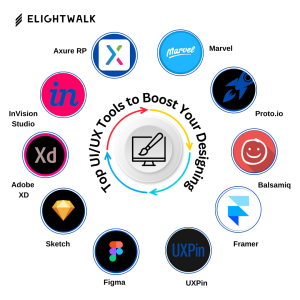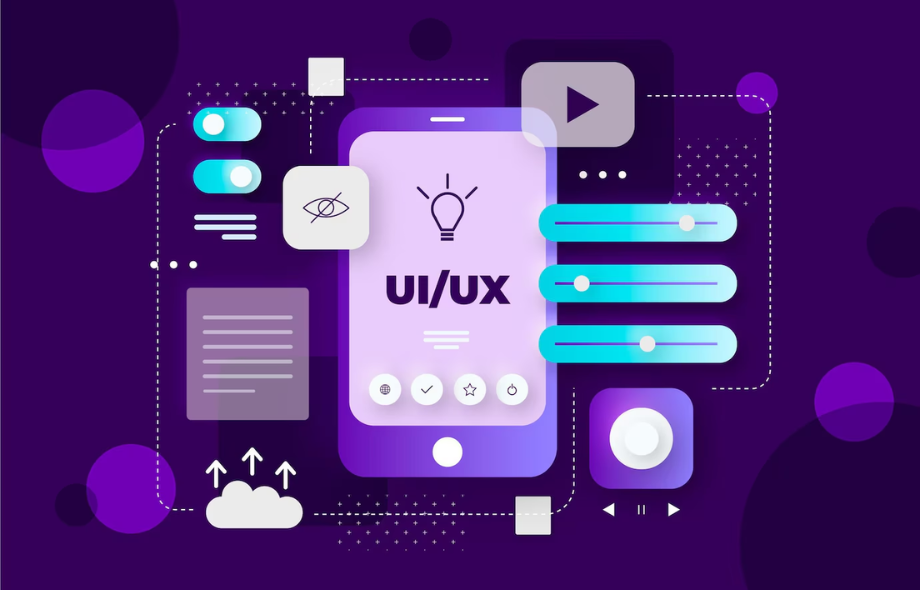When it comes to increasing your productivity and creating a seamless user experience, it’s important to have the right tools at your disposal. In this digital age, many UI/UX tools can help streamline your design process and improve the overall functionality of your products From wireframing and prototyping to user testing and analytics, these tools can have a significant impact on your project’s success. Let’s take a look at the top UI/UX tools to consider to improve your productivity.

UI/UX Tools to Boost Your Designing
1. Figma
Real-time Collaboration: Figma is fully cloud-based, making it easy for teams to collaborate in real time, much like Google Docs for design.
Cross-platform Compatibility: Works seamlessly across Windows, macOS, and even the browser.
Component-Based Design: Components, variants, and auto-layout features enhance consistency and adaptability across designs.
Community and Plugins: A rich library of community-made plugins, templates, and resources.
Pricing: Free or $15 per Month
2. Sketch
Vector-Based Design: Known for its vector editing precision, which makes it ideal for interface and icon design.
Extensive Plugin Ecosystem: Offers a range of plugins to enhance productivity, although primarily limited to macOS.
Libraries and Symbols: Effective for teams needing centralized, reusable components.
Prototyping Tools: Built-in tools for creating simple, interactive prototypes.
Pricing: $10 Per month
3. Adobe XD
Seamless Integration with Adobe Suite: Works well with other Adobe tools like Photoshop, Illustrator, and After Effects.
Auto-Animate Feature: Creates smooth animations and transitions for more dynamic prototypes.
Voice Prototyping: Unique voice interaction and testing options, which are beneficial for voice-based interface designs.
Responsive Resize: Automatically adapts designs to various screen sizes, useful for responsive web design. Scrollable Containers: Easily create scrollable areas within your designs, perfect for presenting large amounts of content in a confined space.
Price: RS.676 per month or $8-10 per month
4. InVision Studio
Advanced Animation: Known for micro-interactions and animations, making it ideal for high-fidelity prototypes.
Integrated Workflow: Combines design, prototyping, and collaboration in one platform.
Version Control and Commenting: Offers centralized design management and team feedback tools.
Shared Design Systems: InVision’s DSM (Design System Manager) promotes consistency across larger design teams.
Price: Ask to customize your Plan
5. Axure RP
Unique Strengths:
Robust Prototyping Capabilities: Ideal for building complex prototypes with interactive elements and logic without needing code.
Detailed Documentation Support: Useful for UX designers who need to create functional specifications or technical documentation.
Advanced Interactions and Conditional Logic: Enables complex, data-driven interactions within prototypes.
Price: $29 per month or $49 per month
6. Marvel
Unique Strengths:
Rapid Prototyping: Ideal for quick wireframes, mockups, and simple prototypes.
User Testing Integration: Includes features to gather feedback directly from users through usability testing.
Handoff Features: Marvel allows for easy developer handoffs, making it ideal for designers needing a fast handoff process.
User Flow and Wireframing Tools: Includes an intuitive user flow and wireframing toolkit for fast iteration.
Price: Free OR $8 per month
7. Proto.io
Drag-and-Drop Interface: Perfect for those who want to build interactive prototypes without coding.
Mobile and Web Prototyping: Known for high-fidelity prototypes for mobile, web, and wearables.
Collaboration and Feedback Collection: Includes commenting features for team members and clients to provide feedback.
Animations and Interactions: Offers a wide array of pre-made animations to bring designs to life easily.
Price: $24 per month
8. Balsamiq
Wireframing Focus: Aimed at low-fidelity wireframing, making it easy to convey ideas quickly.
Hand-Drawn Style: The sketch-like interface prevents over-focusing on visual details and encourages fast ideation.
Simple and Intuitive: Suitable for beginners or team members who may not specialize in UI/UX design.
Collaboration: Offers shared projects and feedback collection to streamline collaboration.
Price: $12 per month
9. Framer
Code-Driven Prototyping: Supports JavaScript for high-fidelity interactions, offering customization beyond standard prototyping tools.
3D and Advanced Animation Support: Includes 3D transformation and complex animations for immersive user experiences.
Easy Handoff and Testing: Allows real-time testing and has simplified handoff features for developers.
Interactive Components: Provides pre-built interactive components for faster prototyping.
Price: Basic Rs.311 per month OR Advance Rs.544 per month
10. UXPin
Code Components: Allows designers to use live code components in prototypes for high-fidelity, functional designs.
Advanced Interactions: Features conditional logic and state management, ideal for building complex prototypes.
Design Systems: Enables design system integration, especially useful for larger, scaling teams.
Accessible Design Tools: Emphasis on accessibility testing, including contrast checkers and other tools for WCAG compliance.
Price: Basic $26/month or Advanced $29/month
Essence
Each of these tools brings unique strengths to different aspects of the design process, from wireframing and prototyping to testing and collaboration. For best results, many designers choose to use a combination of these tools tailored to their specific needs.
Using a combination of these tools, UI/UX designersUI/UX Designers can create a simple workflow that covers all aspects of the design process. Whether it’s wireframing with Figma, handling states through Sketch, or checking for accessibility with tools like contrast checkers, each tool plays an important role in making a successful plan. The value of these tools offering is accessible to designers at all levels. Flexibility and adaptability based on f Ultimately, the key to an effective program that is easy to use is to use the strengths of each tool in ways that complement and enhance overall planning.
 :
https://in.pinterest.com/elightwalk0320/
:
https://in.pinterest.com/elightwalk0320/

